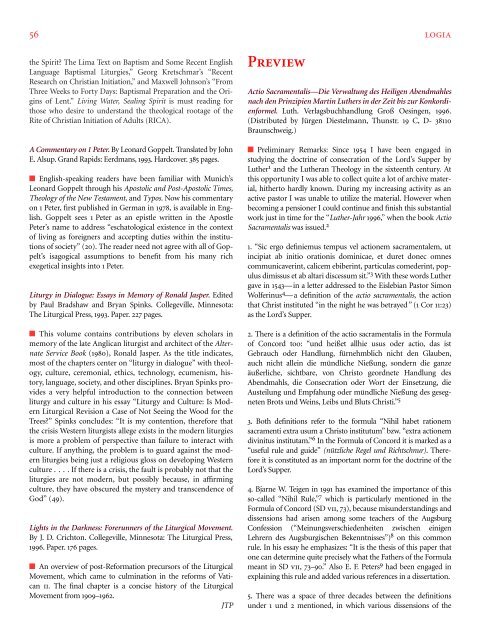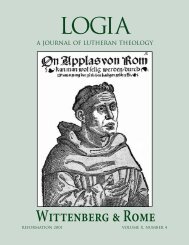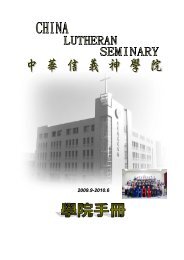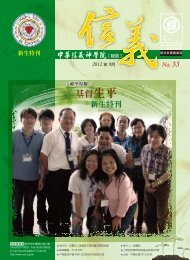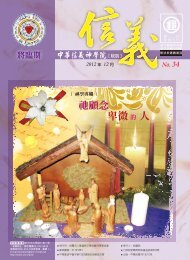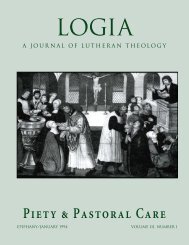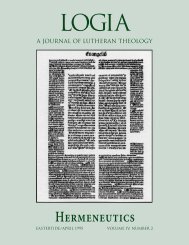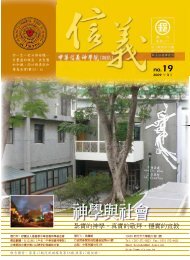05-4 Theology of the..
05-4 Theology of the..
05-4 Theology of the..
You also want an ePaper? Increase the reach of your titles
YUMPU automatically turns print PDFs into web optimized ePapers that Google loves.
56 LOGIA<br />
<strong>the</strong> Spirit The Lima Text on Baptism and Some Recent English<br />
Language Baptismal Liturgies,” Georg Kretschmar’s “Recent<br />
Research on Christian Initiation,” and Maxwell Johnson’s “From<br />
Three Weeks to Forty Days: Baptismal Preparation and <strong>the</strong> Origins<br />
<strong>of</strong> Lent.” Living Water, Sealing Spirit is must reading for<br />
those who desire to understand <strong>the</strong> <strong>the</strong>ological rootage <strong>of</strong> <strong>the</strong><br />
Rite <strong>of</strong> Christian Initiation <strong>of</strong> Adults (RICA).<br />
A Commentary on 1 Peter. By Leonard Goppelt. Translated by John<br />
E. Alsup. Grand Rapids: Eerdmans, 1993. Hardcover. 385 pages.<br />
■ English-speaking readers have been familiar with Munich’s<br />
Leonard Goppelt through his Apostolic and Post-Apostolic Times,<br />
<strong>Theology</strong> <strong>of</strong> <strong>the</strong> New Testament, and Typos. Now his commentary<br />
on 1 Peter, first published in German in 1978, is available in English.<br />
Goppelt sees 1 Peter as an epistle written in <strong>the</strong> Apostle<br />
Peter’s name to address “eschatological existence in <strong>the</strong> context<br />
<strong>of</strong> living as foreigners and accepting duties within <strong>the</strong> institutions<br />
<strong>of</strong> society” (20). The reader need not agree with all <strong>of</strong> Goppelt’s<br />
isagogical assumptions to benefit from his many rich<br />
exegetical insights into 1 Peter.<br />
Liturgy in Dialogue: Essays in Memory <strong>of</strong> Ronald Jasper. Edited<br />
by Paul Bradshaw and Bryan Spinks. Collegeville, Minnesota:<br />
The Liturgical Press, 1993. Paper. 227 pages.<br />
■ This volume contains contributions by eleven scholars in<br />
memory <strong>of</strong> <strong>the</strong> late Anglican liturgist and architect <strong>of</strong> <strong>the</strong> Alternate<br />
Service Book (1980), Ronald Jasper. As <strong>the</strong> title indicates,<br />
most <strong>of</strong> <strong>the</strong> chapters center on “liturgy in dialogue” with <strong>the</strong>ology,<br />
culture, ceremonial, ethics, technology, ecumenism, history,<br />
language, society, and o<strong>the</strong>r disciplines. Bryan Spinks provides<br />
a very helpful introduction to <strong>the</strong> connection between<br />
liturgy and culture in his essay “Liturgy and Culture: Is Modern<br />
Liturgical Revision a Case <strong>of</strong> Not Seeing <strong>the</strong> Wood for <strong>the</strong><br />
Trees” Spinks concludes: “It is my contention, <strong>the</strong>refore that<br />
<strong>the</strong> crisis Western liturgists allege exists in <strong>the</strong> modern liturgies<br />
is more a problem <strong>of</strong> perspective than failure to interact with<br />
culture. If anything, <strong>the</strong> problem is to guard against <strong>the</strong> modern<br />
liturgies being just a religious gloss on developing Western<br />
culture . ... If <strong>the</strong>re is a crisis, <strong>the</strong> fault is probably not that <strong>the</strong><br />
liturgies are not modern, but possibly because, in affirming<br />
culture, <strong>the</strong>y have obscured <strong>the</strong> mystery and transcendence <strong>of</strong><br />
God” (49).<br />
Lights in <strong>the</strong> Darkness: Forerunners <strong>of</strong> <strong>the</strong> Liturgical Movement.<br />
By J. D. Crichton. Collegeville, Minnesota: The Liturgical Press,<br />
1996. Paper. 176 pages.<br />
■ An overview <strong>of</strong> post-Reformation precursors <strong>of</strong> <strong>the</strong> Liturgical<br />
Movement, which came to culmination in <strong>the</strong> reforms <strong>of</strong> Vatican<br />
II. The final chapter is a concise history <strong>of</strong> <strong>the</strong> Liturgical<br />
Movement from 1909–1962.<br />
JTP<br />
PREVIEW<br />
Actio Sacramentalis—Die Verwaltung des Heiligen Abendmahles<br />
nach den Prinzipien Martin Lu<strong>the</strong>rs in der Zeit bis zur Konkordienformel.<br />
Luth. Verlagsbuchhandlung Groß Oesingen, 1996.<br />
(Distributed by Jürgen Diestelmann, Thunstr. 19 C, D- 38110<br />
Braunschweig.)<br />
■ Preliminary Remarks: Since 1954 I have been engaged in<br />
studying <strong>the</strong> doctrine <strong>of</strong> consecration <strong>of</strong> <strong>the</strong> Lord’s Supper by<br />
Lu<strong>the</strong>r 1 and <strong>the</strong> Lu<strong>the</strong>ran <strong>Theology</strong> in <strong>the</strong> sixteenth century. At<br />
this opportunity I was able to collect quite a lot <strong>of</strong> archive material,<br />
hi<strong>the</strong>rto hardly known. During my increasing activity as an<br />
active pastor I was unable to utilize <strong>the</strong> material. However when<br />
becoming a pensioner I could continue and finish this substantial<br />
work just in time for <strong>the</strong> “Lu<strong>the</strong>r-Jahr 1996,” when <strong>the</strong> book Actio<br />
Sacramentalis was issued. 2<br />
1. “Sic ergo definiemus tempus vel actionem sacramentalem, ut<br />
incipiat ab initio orationis dominicae, et duret donec omnes<br />
communicaverint, calicem ebiberint, particulas comederint, populus<br />
dimissus et ab altari discessum sit.” 3 With <strong>the</strong>se words Lu<strong>the</strong>r<br />
gave in 1543—in a letter addressed to <strong>the</strong> Eislebian Pastor Simon<br />
Wolferinus 4 —a definition <strong>of</strong> <strong>the</strong> actio sacramentalis, <strong>the</strong> action<br />
that Christ instituted “in <strong>the</strong> night he was betrayed” (1 Cor 11:23)<br />
as <strong>the</strong> Lord’s Supper.<br />
2. There is a definition <strong>of</strong> <strong>the</strong> actio sacramentalis in <strong>the</strong> Formula<br />
<strong>of</strong> Concord too: “und heißet allhie usus oder actio, das ist<br />
Gebrauch oder Handlung, fürnehmblich nicht den Glauben,<br />
auch nicht allein die mündliche Nießung, sondern die ganze<br />
äußerliche, sichtbare, von Christo geordnete Handlung des<br />
Abendmahls, die Consecration oder Wort der Einsetzung, die<br />
Austeilung und Empfahung oder mündliche Nießung des gesegneten<br />
Brots und Weins, Leibs und Bluts Christi.” 5<br />
3. Both definitions refer to <strong>the</strong> formula “Nihil habet rationem<br />
sacramenti extra usum a Christo institutum” bzw. “extra actionem<br />
divinitus institutam.” 6 In <strong>the</strong> Formula <strong>of</strong> Concord it is marked as a<br />
“useful rule and guide” (nützliche Regel und Richtschnur). Therefore<br />
it is constituted as an important norm for <strong>the</strong> doctrine <strong>of</strong> <strong>the</strong><br />
Lord’s Supper.<br />
4. Bjarne W. Teigen in 1991 has examined <strong>the</strong> importance <strong>of</strong> this<br />
so-called “Nihil Rule,” 7 which is particularly mentioned in <strong>the</strong><br />
Formula <strong>of</strong> Concord (SD VII, 73), because misunderstandings and<br />
dissensions had arisen among some teachers <strong>of</strong> <strong>the</strong> Augsburg<br />
Confession (“Meinungsverschiedenheiten zwischen einigen<br />
Lehrern des Augsburgischen Bekenntnisses”) 8 on this common<br />
rule. In his essay he emphasizes: “It is <strong>the</strong> <strong>the</strong>sis <strong>of</strong> this paper that<br />
one can determine quite precisely what <strong>the</strong> Fa<strong>the</strong>rs <strong>of</strong> <strong>the</strong> Formula<br />
meant in SD VII, 73–90.” Also E. F. Peters 9 had been engaged in<br />
explaining this rule and added various references in a dissertation.<br />
5. There was a space <strong>of</strong> three decades between <strong>the</strong> definitions<br />
under 1 und 2 mentioned, in which various dissensions <strong>of</strong> <strong>the</strong>


